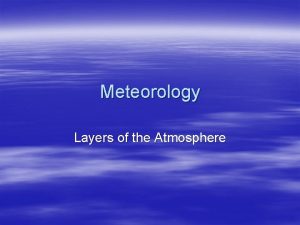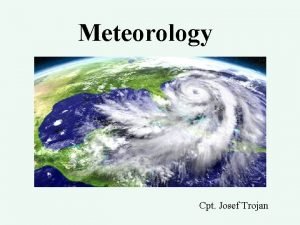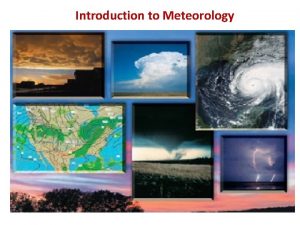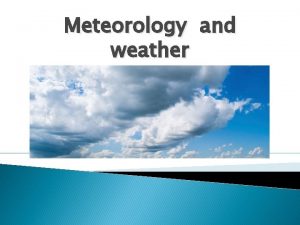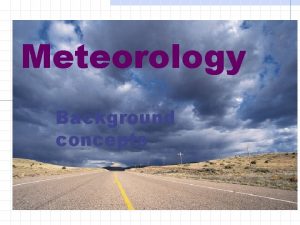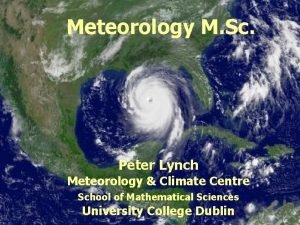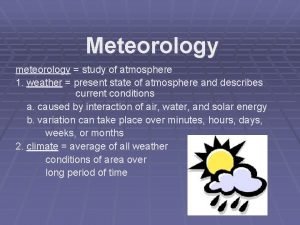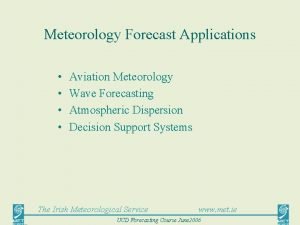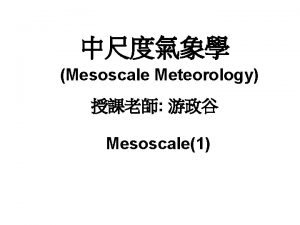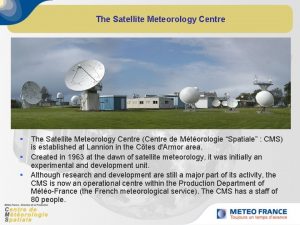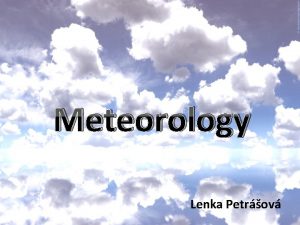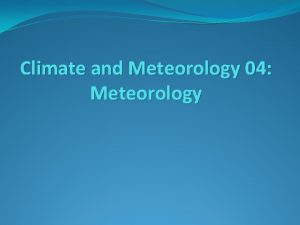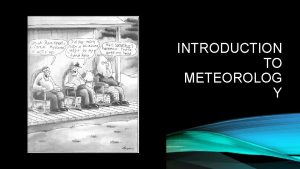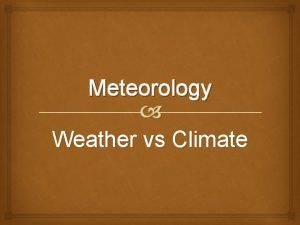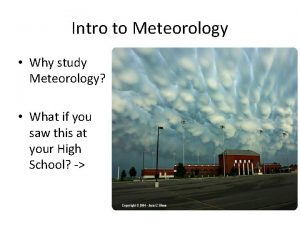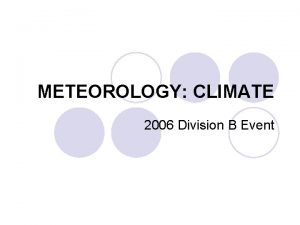Meteorology notepacket information What is Meteorology Meteorologyis the





















- Slides: 21

Meteorology notepacket information

What is Meteorology? • Meteorologyis the interdisciplinary scientific study of the atmosphere…. • Composition of Earth’s Atmosphere: – Nitrogen – Oxygen – Carbon Dioxide – trace water vapor

Composition and structure of Atmosphere

Make this tableon the back of yournote packet:


Let’s relate these to things we know • From Hellgate to: use google earth – convert Kilometer to miles: 5 k = ____ mi Temperature ranges: Celsius to Fahrenheit – O C = ____F – 100 C = ______ F – What is the conversion?

As you increase in altitude then ________ changes? • Temperature: • Pressure:


The Earth’s solar budget

Earth’s greenhouse vs Venus’

Is one more important than an other? Greenhouse temperature lab Based on the data and reflections from our greenhouse lab, what other variables contribute to temperature changes on a planet?

Properties of water Cohesion and adhesion The cohesion of water is due to the action of hydrogen bonds between water molecules and other polar molecules. the strength of the bonds allow water to stick to itself, and other things. One of these is why water striders can walk on the surface of the water, that is due to waters surface tension. Water absorbs and releases heat An important property of water is its capacity for energy absorption and release, which affects energy flow and temperatures. This property is collectively called water’s high specific heat capacity.

Ice floats on water Unlike most substances, the solid form of water (ice) is less dense than that of the liquid form, which allows ice to float on water. Water is one of the few substances on earth found in all three states of matter. It is unique that in its solid state it actually expands due to its crystalline structure which makes it float on the liquid form of itself. Water as a Solvent Water is often referred to as the universal solvent, because it is able to dissolve many types of substances due to its polarity.

Greenhouse Gases • What are the most common greenhouse gases? • How are they produced? • What are the pro’s and con’s to these gases? • Compare and contrast too much vs not enough?

One variable to our atmosphere

Regarding pressure and temperature • Why do climbers of MT Everest need to carry • oxygen to the top? Why do they need to pace themselves in the climbing process and acclimate ever few thousand feet at a base camp? • Is there truly less Air/ Oxygen? • Why is it harder to breath?

What makes this possible? List the variables:

Ozone • What is it? • The chemical known as ozone is 03, earth’s protective layer from UV radiation • How is it created ? • It is naturally created in the atmosphere, and • changes due to seasons, latitude, sunspots Where is it normally found ? • Depletion is increasing due: • increase use of CFC’s – in refrigerants, aerosols, solvents, fire extinguishers, styrofoam

• Figure 2: Altitude • • distribution of ozone in the atmosphere. The blue curve indicates a typical altitude profile of ozone showing no depletion. The high abundance of ozone near 15 km marks the center of the normal ozone layer. The red curve was obtained over South Pole, Antarctica, in winter. The ozone layer has been severely depleted at this location as indicated by the near zero values between 14 and 20 km. Similar depletion occurs over the entire Antarctic region in late winter/early spring, causing the Antarctic "ozone hole" in satellite observations of Antarctic ozone.

• What does this • • information mean? What is the potential affect on people in the southern hemisphere? NASA daily readings • What other continents would be impacted by less ozone in this area?

Some Ozone stats: • CFC’s only break down under UV light – One atom of Chlorine can break down 100, 000 molecules of ozone • Think of the Ozone like a river, in that it is the depth in certain locations that changes and become dangerous. • Since 1980, ozone levels over the poles has fallen 60%, over the northern hemisphere 5 -10 %
 Mật thư anh em như thể tay chân
Mật thư anh em như thể tay chân Lời thề hippocrates
Lời thề hippocrates Vẽ hình chiếu đứng bằng cạnh của vật thể
Vẽ hình chiếu đứng bằng cạnh của vật thể Tư thế worms-breton
Tư thế worms-breton Quá trình desamine hóa có thể tạo ra
Quá trình desamine hóa có thể tạo ra Sự nuôi và dạy con của hổ
Sự nuôi và dạy con của hổ Các châu lục và đại dương trên thế giới
Các châu lục và đại dương trên thế giới Dot
Dot điện thế nghỉ
điện thế nghỉ Bổ thể
Bổ thể Nguyên nhân của sự mỏi cơ sinh 8
Nguyên nhân của sự mỏi cơ sinh 8 Làm thế nào để 102-1=99
Làm thế nào để 102-1=99 Thiếu nhi thế giới liên hoan
Thiếu nhi thế giới liên hoan Fecboak
Fecboak Chúa yêu trần thế alleluia
Chúa yêu trần thế alleluia Một số thể thơ truyền thống
Một số thể thơ truyền thống Hệ hô hấp
Hệ hô hấp Cong thức tính động năng
Cong thức tính động năng Số nguyên tố là số gì
Số nguyên tố là số gì Tư thế ngồi viết
Tư thế ngồi viết Tỉ lệ cơ thể trẻ em
Tỉ lệ cơ thể trẻ em đặc điểm cơ thể của người tối cổ
đặc điểm cơ thể của người tối cổ






















